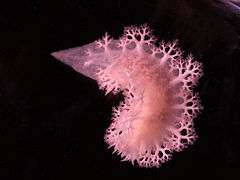Tritoniopsis elegans
| Tritoniopsis elegans | |
|---|---|
 | |
| Tritoniopsis elegans | |
| Scientific classification | |
| Kingdom: | Animalia |
| Phylum: | Mollusca |
| Class: | Gastropoda |
| (unranked): | clade Heterobranchia clade Euthyneura |
| Superfamily: | Tritonioidea |
| Family: | Tritoniidae |
| Genus: | Tritoniopsis |
| Species: | T. elegans |
| Binomial name | |
| Tritoniopsis elegans (Audouin in Savigny, 1826)[1][2] | |
| Synonyms[2][3] | |
| |
Tritoniopsis elegans is a species of dendronotid nudibranch. It is a marine gastropod mollusc in the family Tritoniidae and is found in the western Indo-Pacific. It was first described by the French naturalist Jean Victoire Audouin in 1826, the type specimen being found in the Red Sea.
Description
Tritoniopsis elegans is a slender nudibranch growing to about 5 cm (2 in), with several pairs of dendritic (branching) cerata and rhinophores tipped with short tentacles. It varies in colour from translucent clear to translucent orange or orange-red and has a pattern of white opaque markings. The different colour forms do not seem to be a result of the animals' diet because the two forms sometimes occur alongside each other when the animals are feeding on the same colonial soft coral.[4] The white form used to be known as Tritoniopsilla alba but this is now considered to be a synonym for T. elegans.[5]
Distribution and habitat
Tritoniopsis elegans is found in the western Indo-Pacific. It is known from the Red Sea, Tanzania, Japan, New Caledonia and eastern Australia. It is found on shallow water reefs, normally on the soft corals on which it feeds, but it is nocturnal and so is easily overlooked.[4] In 2007, T. elegans was observed in Hawaii for the first time, having not been included in any previous surveys of marine invertebrates on the islands.[6]
Ecology
Tritoniopsis elegans is one of the only predators to feed on the invasive octocoral Carijoa riisei.[7] The only other known predators on this coral are the aeolid nudibranch Phyllodesmium poindimiei and the bearded fireworm Hermodice carunculata.[7]
T. elegans also feeds on the Chinese octocoral Cladiella krempfi, and it has been found that the unusual diterpenes present in that coral accumulate in the nudibranch's mantle.[8]
References
- ↑ Audouin V. (1826). "Explication sommaire des planches de Mollusques de l'Egypte et de Syrie publiees par J.C. Savigny. Description de l'Egypte ou recueil des observations et des recherches qui ont été faites en Egypte pendant l'expedition de l'armée françaises, publie par les ordres de sa majeste l'empereur Napoleon le grand." Histoire Naturelle, Animaux invertebres 1(4): 7–56. Imprimiere imperiale, Paris.
- 1 2 Rosenberg, Gary (2014). "Tritoniopsis elegans (Audouin, 1826)". World Register of Marine Species. Retrieved 2015-03-20.
- ↑ McDonald G. R. (2006). Nudibranch Systematic Index.
- 1 2 Rudman, Bill (1999-01-04). "Tritoniopsis elegans (Audouin, 1826)". Sea Slug Forum. Retrieved 2015-03-20.
- ↑ Rudman, Bill (2008-09-19). "Tritoniopsis elegans – egg laying". Sea Slug Forum. Retrieved 2015-03-20.
- ↑ Wagner, D.; Kahng, S. E.; Toonen, R. J. (2007). "New report of nudibranch predators of the invasive octocoral Carijoa riisei in the Main Hawaiian Islands". Coral Reefs 26 (2): 411. doi:10.1007/s00338-007-0232-z.
- 1 2 Souza, J. R. B.; Rodrigues, H. A.; Neves, B. M.; Perez, C. D. (2007). "First report of bristleworm predator of the reef octocoral Carijoa riisei". Coral Reefs 26 (4): 1033. doi:10.1007/s00338-007-0290-2.
- ↑ Cai, You-Sheng; Yao, Li-Gong; Di Pascale, Antonio; Irace, Carlo; Mollo, Ernesto; Taglialatela-Scafati, Orazio; Guo, Yue-Wei (2013). "Polyoxygenated diterpenoids of the eunicellin-type from the Chinese soft coral Cladiella krempfi". Tetrahedron 69 (9): 2214–2219. doi:10.1016/j.tet.2012.12.051.
| Wikimedia Commons has media related to Tritoniopsis elegans. |
Further reading
- Baba K. (1969). "Taxonomic study on Tritoniopsis elegans (Audouin, 1826) from Seto, Japan (Nudibranchia – Dendronotoidea)". Publications of the Seto Marine Biological Laboratory 16(6): 395–398, pl. 26.